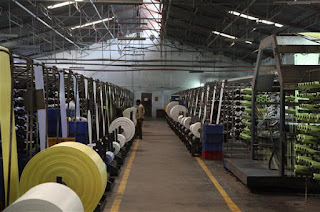woven sack tutorial - woven sack production process
• How to plan for UnCoated Bag
Firstly we
should know some basic information, Like
• Size of the bag
• Weight of bag required or GSM
• Stitching type
• Strength requirement
• Color of the bag
Etc.
• Size of the bag
Bag are
made of different types
Like
Bags from
tubular fabric- normal packing bags, valve
bags. Etc.
Bags from
flat fabric – Box Bag, Envelope
Bag, etc.
• Weight
of Uncoated Oven Bag or GSM or Gramage (local market language)
If we know either of GSM or GPB ( Gram Per Bag) or Gramage
(used in local market), we can calculate easily other related things like, Raw
material Requirement, Tape Denier, Quantity of fabric to be manufactured,
Quantity of tape etc.
• Stitching type
There are
many types of stitching done in the bag.
Like
• SFSS
(Single Fold Single Stitch)
• DFDS
(Double Fold Double Stitch)
• SFDS
(Single Fold Double Stitch)
• DFSS
(Double Fold Single Stitch )
• EZ
With Fold
• EZ
Without Fold
Etc.
• STRENGTH
DEMAND IN BAG
To decide
the mixing recipe, it is very important to know the demand of strength, the
most important is mixing recipe in costing, because according to the need, many
types of additives are added to the recipe, which are directly related to the
strength and elongation %.
• Color Of the BAG
it can
be made of any color as per the demand, As mixing is the most important recipe
in costing, as per the requirement, different types of additives are added to
the recipe and as the cost of different color master batch is also different.
• Let us take an example to understand
the calculation further.
For example
a 20" X 36" white uncoated oven bag weighing 100 g, mesh 10 X 10 and
top hemming and bottom should have SFSS, weaving flat. Quantity 50000 bags.
(GSM and GRAMAGE will also be discussed in this example.)
• First
note down the available information.
• GPB
- 100 grams
• Size
- 20" X 36"
• Stitching
- Top Hemming and Bottom SFSS
• Weaving
Type – Flat
• Mesh
10 X 10
Now let's decide the cut length first.
Since, the
stitching is top hemming and bottom is SFSS, add 1" for hemming and
1.5" for SFSS to the bag size. The length of the bag is 36", adding
2.5" to it i.e. the cut length becomes 38.5".
Now let us understand this by the unitary method.
Since, we need 38.5" long fabric to make a bag.
So, to make 50000 bags, 50000 X 38.5" = 1925000"
Now let us understand it again by the unitary method to know
it in meters.
Since, 1 meter in 39.37"
then, 1/39.37 Meter in 1"
So in "1925000" =
1925000∗1/39.37
=48895
meters
Since many types of wastage are also made while making
fabric, therefore some % more fabric is made than the required fabric. Usually
3%.
Hence 48895 + 3% = 50361 meters
=50400
meters on roundup
Now, We know how much fabric to make, So we have to calculate
how much tape will have to be made.
Since the weight of a bag is 100 grams, one thing to note
here is that the weight of the thread is also included in the weight of the
bag,
The correct way to know the actual weight of the thread used
in sewing is to untie the thread of the sample bag and weigh it, here we take
it as 3 grams.
so 100-3=97 grams
This means 20" X 38.5" fabric weighs 87 grams.
Now we have to first calculate the GPM, so that we can find
out the total number of tapes to be made, then GSM and then Denier.
(Gramage used in local market means GPM divided by tubular
width in inches.)
Again understand from the unitary method.
Note:- Size doesn't matter to calculate GPM.
So,
Since, the weight of 38.5" fabric is 97 grams,
So, the weight of 1" fabric will be 97/38.5 grams,
So, 39.37" of fabric will weigh = (97∗39.37)/38.5
grams. (39.37” in 1 meter)
= 99.19 grams
(If the gramage of this fabric is to be obtained, then
99.19/20 = 4.96 grams)
Now the GSM of this fabric comes out.
Since we know the GPM, we again calculate the GSM by the
unitary method.
Now if the weight of 40” (20X2) is 99.19 grams,
So, the weight of 1" will be 99.19/48 grams,
Hence the weight of 39.37 will be =
GSM = 97.63 grams
Now take out the denier
Fabric GSM = (Warp mesh + Weft mesh) x Denier/228.6
(Watch the video in the description to know the full
formula)
Denier = Fabric GSM X 228.6 / (Warp mesh + Weft mesh)
=
= 1116 denier
(Since the denier variation in a tape plant is around 3 -
8%, So actual denier should be 3 - 4% less than the calculated denier )
Now let's calculate how much tape will have to be made in
total,
Since we know GPM, then again calculate by unitary method.
Since, the weight of 1 meter of fabric is 97.63 grams,
So, weight of 50400 meter fabric = 50400*97.63 grams
=
4920552 grams
=
4920.552 KG
There will be some tape left over after the fabric on the
loom, so extra tape will need to be made. Generally, the weight of one
remaining bobbin is taken as 700 grams. So here 20 X 2 X 10 X 0.7 = 280 kg
extra. Total Tape 5200 KG Approx.
To understand more similar calculations and formulas, watch
the video given in the description.
If you do not understand anything, then definitely tell in
the comment box.



Based on these parameters, how do we decide the recipe?
ReplyDelete